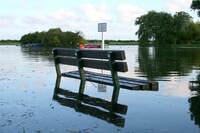- England
- Scotland
- France
- Holland
- Germany
- Italy
- Spain
- Portugal
- USA
- China
- Japan
- India
- Iran
- Advice
- Gardens
- England
- Scotland
- France
- Holland
- Germany
- Italy
- Spain
- Portugal
- USA
- China
- Japan
- India
- Iran
- Advice
- Garden Tours
Book: Landscape Planning and Environmental Impact Design: from EIA to EID
Chapter: Chapter 9 River engineering, channelization and floods
Floods induce fear - and high expenditure.
Men have always been frightened of floods. They are the subject of numerous legends and remain the chief cause of natural disasters (Parker & Harding 1978: 234). In The Bible we read that: In the six hundredth year of Noah's life... were all the fountains of the great deep broken up, and the windows of heaven were opened. And the rain was upon the earth forty days and forty nights... And all flesh died that moved upon the earth, both of fowl, and of cattle, and of beast, and of every creeping thing that creepeth upon the earth, and every man (Genesis Chapter 7). Most floods are caused by heavy rain or high seas. Other occasional causes include earthquakes, snowmelt, landslides and dam failures. The worst UK floods in recent times have been the Dale Dyke dam failure of 1864, the Lynmouth river flood of 1952 and the East Coast floods of 1953. They claimed 244, 28, and 300 lives respectively. The language in which these events were described by contemporary observers reveals the fear which they engendered. This is what happened at Dale Dyke: On Friday, March 11, 1864, exactly at midnight, a calamity, appalling and almost unparalleled, occurred along the course of the river Loxley, and the banks of the Don, where it passes through the town of Sheffield. An overwhelming Flood swept down from an enormous reservoir at Bradfield, carrying away houses, mills, bridges, and manufactories, destroying property estimated at half a million sterling in value, and causing the loss of about two hundred and forty human lives. (Harrison 1864). Authorities respond to the fear of floods by spending munificiently on flood protection measures. Simultaneously, societies take many actions, often for good reasons, which increase the flood risk: forest clearance, agricultural drainage, urban drainage and river 'improvement' [Fig 9.1].
